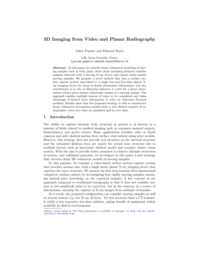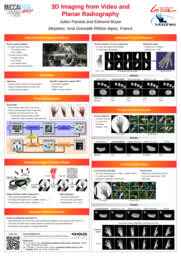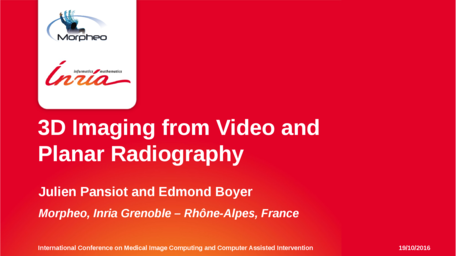3D Imaging from Video and Planar Radiography
Julien Pansiot and Edmond Boyer
MICCAI 2016

Abstract
In this paper we consider dense volumetric modeling of moving samples such as body parts. Most dense modeling methods consider samples observed with a moving X-ray device and cannot easily handle moving samples. We propose a novel method that uses a surface motion capture system associated to a single low-cost/low-dose planar X-ray imaging device for dense in-depth attenuation information. Our key contribution is to rely on Bayesian inference to solve for a dense attenuation volume given planar radioscopic images of a moving sample. The approach enables multiple sources of noise to be considered and takes advantage of limited prior information to solve an otherwise ill-posed problem. Results show that the proposed strategy is able to reconstruct dense volumetric attenuation models from a very limited number of radiographic views over time on simulated and in-vivo data.
Files
 Paper |
 Poster |
 Presentation |
Bibtex reference
@inproceedings{pansiot16xrays3d,
author = {Julien Pansiot and Edmond Boyer},
title = {{3D} Imaging from Video and Planar Radiography},
booktitle = {International Conference on Medical Image Computing and Computer Assisted Intervention (MICCAI)},
year = 2016,
month = Oct,
address = {Athens},
publisher = {Springer},
editor = {S. Ourselin et al.},
series = {LNCS},
volume = 9902,
chapter = 52,
pages = {450-457},
doi = {10.1007/978-3-319-46726-9\_52},
url = "http://dx.doi.org/10.1007/978-3-319-46726-9_52",
eprint = "http://julien.pansiot.org/papers/2016_Pansiot_MICCAI_Xrays3d_HALv2.pdf",
video = "http://julien.pansiot.org/suppl/2016_Pansiot_MICCAI_Xrays3d.mp4",
}